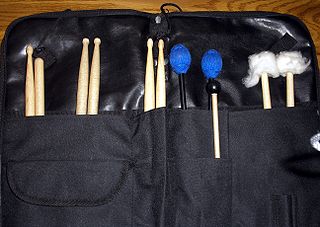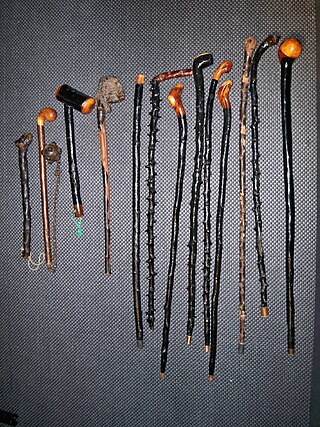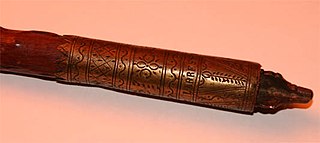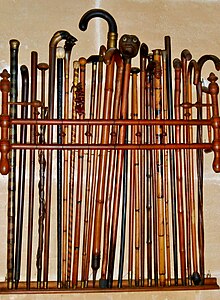
A staff of office is a staff, the carrying of which often denotes an official's position, a social rank or a degree of social prestige.

Rattan, also spelled ratan, is the name for roughly 600 species of Old World climbing palms belonging to subfamily Calamoideae. The greatest diversity of rattan palm species and genera are in the closed-canopy old-growth tropical forests of Southeast Asia, though they can also be found in other parts of tropical Asia and Africa. Most rattan palms are ecologically considered lianas due to their climbing habits, unlike other palm species. A few species also have tree-like or shrub-like habits.

A percussion mallet or beater is an object used to strike or beat a percussion instrument to produce its sound.

A club is a short staff or stick, usually made of wood, wielded as a weapon since prehistory. There are several examples of blunt-force trauma caused by clubs in the past, including at the site of Nataruk in Turkana, Kenya, described as the scene of a prehistoric conflict between bands of hunter-gatherers 10,000 years ago.

An assistive cane is a walking stick used as a crutch or mobility aid. A cane can help redistribute weight from a lower leg that is weak or painful, improve stability by increasing the base of support, and provide tactile information about the ground to improve balance. In the US, ten percent of adults older than 65 years use a cane, and 4.6 percent use walkers.

Stick-fighting, stickfighting, or stick fighting, is a variety of martial arts which use simple long, slender, blunt, hand-held, generally wooden "sticks" for fighting, such as a gun staff, bō, jō, walking stick, baston, arnis sticks or similar weapons. Some techniques can also be used with a sturdy umbrella or even with a sword or dagger in its scabbard.

A swordstick or cane-sword is a cane containing a hidden blade or sword. The term is typically used to describe European weapons from around the 18th century. But similar devices have been used throughout history, notably the Roman dolon, the Japanese shikomizue and the Indian gupti.

A swagger stick is a short stick or riding crop usually carried by a uniformed person as a symbol of authority. A swagger stick is shorter than a staff or cane, and is usually made from rattan. Its use derives from the vine staff carried by Roman centurions as an emblem of office.
Trekking poles are a common hiking accessory that function to assist walkers with their rhythm, to provide stability, and reduce strain on joints on rough terrain.

A pace stick is a long stick usually carried by warrant officer and non-commissioned officer drill instructors in the British and Commonwealth armed forces as a symbol of authority and as an aid to military drill.

A shillelagh is a wooden walking stick and club or cudgel, typically made from a stout knotty blackthorn stick with a large knob at the top. It is associated with Ireland and Irish folklore.

A cane gun is a walking cane with a hidden gun built into it. Cane guns are sometimes mistaken for similar looking "poacher's guns".

Canne de combat is a French combat sport. As weapon, it uses a canne or cane designed for fighting. Canne de combat was standardized in the 1970s for sporting competition by Maurice Sarry. The canne is very light, made of chestnut wood and slightly tapered. A padded suit and a fencing mask are worn for protection.

The makila is a traditional Basque walking stick, and is notable as both a practical tool and a cultural symbol of authority and strength.

A mobility aid is a device that helps individuals with mobility impairments to walk or improve their overall mobility.

Stick candy is a long, cylindrical variety of hard candy, usually four to seven inches in length and 1/4 to 1/2 inch in diameter, but in some extraordinary cases up to 14 inches in length and two inches in diameter. Like candy canes, they usually have at least two different colors swirled together in a spiral pattern, resembling a barber's pole.
A walking stick is a device used primarily to aid walking that may also provide postural support or serve as a fashion accessory or means of self-defense.

Cane is any of various tall, perennial grasses with flexible, woody stalks from the genera Arundinaria, and Arundo.

Listed here are the weapons of pencak silat. The most common are the machete, staff, kris, sickle, spear, and kerambit. Because Southeast Asian society was traditionally based around agriculture, many of these weapons were originally farming tools.

The baston is one of the primary weapons of Arnis and Filipino martial arts. It is also known as yantok, olisi, palo, pamalo, garrote, caña, cane, arnis stick, eskrima stick or simply, stick.






















